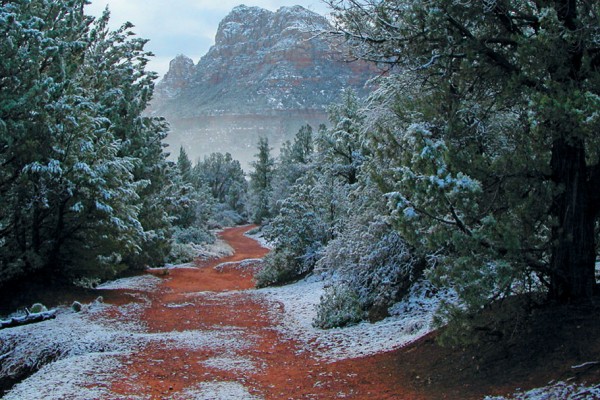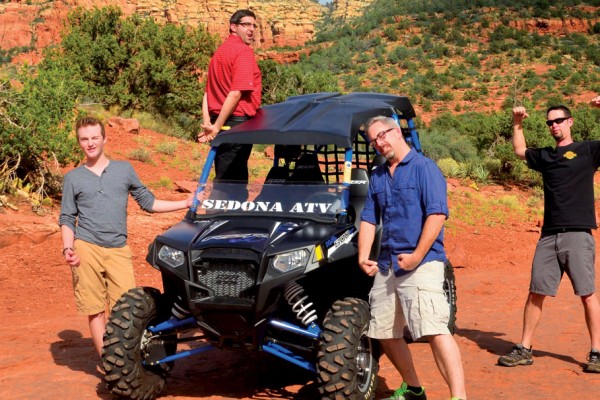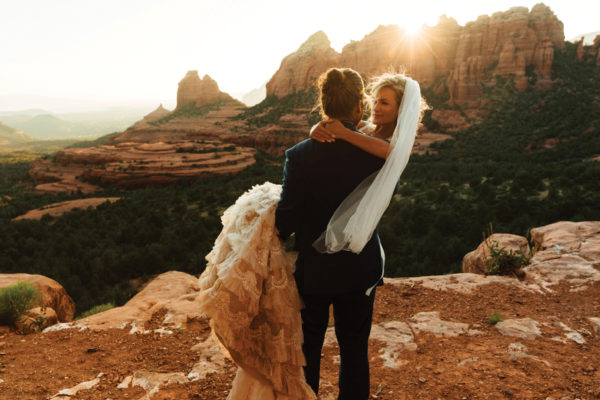Continued (page 2 of 2)
The story that captured our hearts the most involved Leonardo, a 13-year-old African leopard. Leonardo was bred for the Las Vegas entertainment industry. His canine teeth and all of his claws were pulled in order to keep his trainers “safe.” After two years, he was sold to a small zoo in Douglas, Ariz., where he spent seven years living in a 10-foot-by-12-foot enclosure. “The owners encouraged people to throw things at him so he would charge his cage,” says Linda as she feeds Leonardo raw chicken through his fence. “The floor of his cage was lower than the ground around him, so when it rained he had two choices: sit out in the rain or lay in a puddle in his cage.”
When SWCC finally rescued Leonardo in 2011, he had a collapsed lung, severe pneumonia and mutilated feet. And he absolutely detested humans. But Linda and her staff gave the leopard a large enclosure with grass that is easier on his paws. He has a perch where he can survey his surroundings and toys he bats around. He also has a fetish for the smell of diluted orange extract, which makes him roll on his back like a kitten. (The bobcats have a thing for the smell of Italian seasonings, says Kim.) Today, as soon as Linda walks by the enclosure, he comes to greet her. Somehow, Leonardo has found it in his heart to forgive. Linda, also, seems to have a great capacity for forgiveness when it comes to the atrocities committed against animals that she hears about daily.
“Ultimately, it’s rewarding to be able to help these animals, but I’m always thinking about the ones out there that need to be rescued,” she says.
About 70 percent of the animals SWCC rescues are released into the wild. The critters are released at different times of the year depending on the animals’ age and species, though many releases occur in the early fall during breeding season. Pack animals, such as javelina, are rehabilitated and released as herds. Linda says it was actually easier for her to release animals in the early years than it is now. “There was more habitat back then,” she says. “Now, with development and with the drought, I know the odds of survival, and that makes it difficult. When we go to release an animal, some are afraid to leave their cage while others bolt out. But almost every single one stops, turns around and looks back.”
So how does Ken Rowe come into this picture?
Ken, who co-owns Rowe Fine Art Gallery with his wife, Monica, learned about SWCC three years ago when a collector gave him the scoop on the rehab center. Ken, who is also an Arizona native, has been sculpting wildlife full time for almost 20 years, and he’s passionate about studying and sculpting animals in the field. He contacted Linda, who invited him to visit the center and sculpt on-site. Ken took her up on the offer and spends days at a time in Scottsdale, sculpting animals from just inches away. His bobcat bronze, Cantankerous, is based on Sage and several other bobcats from SWCC. Flora and Fauna features Nalani, a fawn that lives at SWCC.
“I’ll spend several days in a row down here, and I’ll create sketches of several animals,” says Ken. “Most people are surprised that I use live references, but I just can’t use photos. I’ve tried, and I can’t do it. I’ve developed an eye for capturing the personality of what I’m sculpting – an inspired piece of work comes from the animal.”
Ken started sculpting in 1987. His mom, who used to draw and paint, and his love of the outdoors inspired him to create art. But before he was a sculptor, he and Monica owned a taxidermy studio in Phoenix for 14 years. He says his intense study of anatomy and wildlife physiology has helped make him a successful sculptor. But it’s clearly more than scientific accuracy that has garnered Ken a huge following and a laundry list of awards including numerous honors from the Society of Animal Artists. Spend a day with Ken and the animals at SWCC, and it becomes clear he has an uncanny bond with the creatures. It was Ken who elicited the purr from Tocho. He has spent hours studying the mountain lion and sculpting in front of his enclosure. Tocho seemed to be greeting him like an old friend.
“My mom always said if you’re going to paint an apple, you have to buy two and eat one,” says Ken. “You must know your subject matter. When an animal breathes on me, I notice the flare of its nostrils and the way its eyes squint. The breath influences the volume of a piece. When I witnessed a mountain lion attack and saw how fast and strong he was, it changed the piece I was working on.”
When sculpting in the field, Ken uses clay to create sketches just like a painter might use a pencil and a sketchpad to generate ideas. It’s not unusual for Ken to sketch one animal’s face on another animal’s body, and he’s also likely to sculpt an animal three or four times before winding up with a piece that will be cast in bronze and sold in the gallery. Ken is the first to admit that while he loves sculpting, he can’t get enough of his time in the field, whether he’s visiting SWCC or spending weeks camping in Alaska or Jackson Hole, Wyo.
“I’m addicted to the creative process,” he says. “There’s this sense of accomplishment I get from doing it right – from creating an animal out of clay and doing it justice. When I get the chance to spend time with these animals, to me, it’s like spending time with a celebrity.”
Lucky for the rest of us, Ken isn’t the only one who can spend time with these “celebrities.” SWCC is open to the public seven days a week by appointment. Admission is a suggested donation of $15 per person. Funds go toward SWCC’s annual operating budget of $600,000. The 501(c)3 also has a wish list on www.amazon.com where animal lovers can purchase food, toys and supplies and have them sent to the center. (Hint: The three black bears have a thing for peanut butter.) For more information, visit www.southwestwildlife.org or call 480-471-9109.
MORE SEDONA ROAD TRIPS: Lake Powell, Havasu Canyon, photographing Arizona, 3 slot canyons, 10 places to go to beat the Arizona heat, Acoma Pueblo, Grand Canyon, The Wave, Oak Creek Canyon, Crown King, Jerome, Sunset Crater Volcano, Wupatki National Monument, Arizona animal parks, Monument Valley, Phoenix’s Musical Instrument Museum, Navajo National Monument, Mormon Lake, Canyon de Chelly



